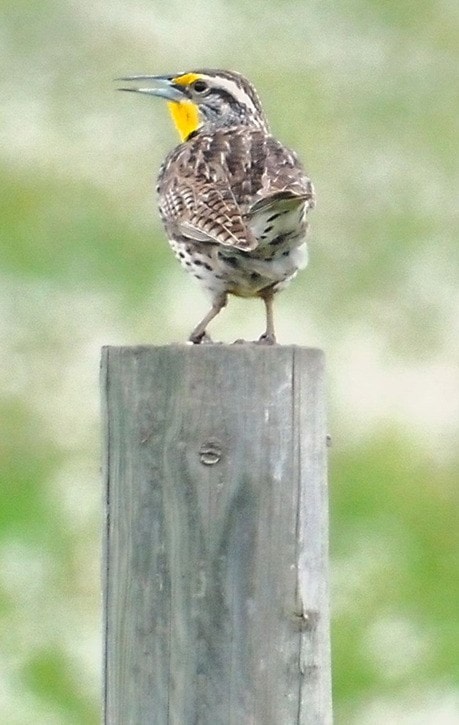Western meadowlarks are a common bird here in summer, breeding in farmland on the Kootenay River flats and on the Lister and Canyon district bench lands. They find the manmade prairie-like landscape in these areas suitable for hunting ground insects, including grasshoppers, in various stages of development. What is not so common, in fact very unusual, is to have even one meadowlark hanging out here in the winter. But two were reported in the Dec. 27 Christmas Bird Count.
Our winters and winter conditions come earlier than places farther south. In past years, meadowlarks have been seen here in January.
Kootenay winters are typically such that meadowlarks and many other birds that depend heavily on an insect menu would find it impossible to survive. However, periodically, there have been mild enough winters to make food and water more readily available to normally migrating birds. So, some birds will stick around for the winter or part of it. For a meadowlark or two, milder conditions combined with cattle feedlots and loafing areas provide food, water and shelter, and that is about all they need to survive, even in winter. Freezing or about freezing temperatures don’t seem to adversely affect a few wintering meadowlarks, varied thrushes, towhees and other hardy birds, as long as their needs are supplied. As of Jan. 21, the notable little rufous hummingbird was still alive and well, hanging around in a human-created “microclimate”.
To some people, Canada geese calling from overhead in winter give hope of spring. Well, to see a meadowlark in January, just picking up gravel grit along the roadside or pecking here and there while ambling over the rough “terrain” in a cattle feedlot, is a call to dream of fresh, green grass in the early morning sunlight or amber evening fading and the melodious call of the western meadowlark. (You can hear it if you go online.)
I was thinking of how the meadowlark fits into the array of blackbirds and starlings. I see that the beak is very similar, sort of a slight downward bend, a robust base leading out to a very sharp point. I thought that is also quite starling-like. In fact, they both get around in a similar fashion. They usually walk about, but also run if in pursuit of some tasty insect. That is very much un-robin-like, which is hopping about, also, like sparrows and juncos. A hundred or 200 starlings heading on foot, like an army, across a feedlot searching for tasty bits is quite impressive. But meadowlarks, being more solitary, do not usually put on that kind of showing.
The melodious meadowlark call (or song) has similarities to the early morning repertoire of a starling perched on an eavestrough preening its feathers in the warm, early morning sunrays. The whistled, flutelike notes sound a bit like those of the meadowlark. Once, when a starling was whistling away, someone asked me if it was a meadowlark calling. Starlings are mimics.
Colourwise, of course, the meadowlark and starling are strikingly different. Most of the time, a starling appears to have a dingy black “coat”, while the meadowlark is striped in browns accented by a brilliant yellow throat and upper breast. Both have stubby bodies and are quite ungraceful in flight, moving from one spot to another with a rapid whirr of wings, ending in an abrupt landing.
This mild winter has encouraged several other summer residents to show up in this winter season. Perusing them is about going where there is accessible food, water and shelter in the way of treed and brushy field, stream and ditch edges, low traffic road borders and, of course, bird feeders. Check out acquaintance’s bird-feeding stations. Specifically, but perhaps without success, one might search, of course, for western meadowlarks, adding to that towhee, tree sparrow and catbird. The birds you might more readily see, which are here all winter, are the (eastern) blue jay, brown creeper, winter (Pacific) wren, water dipper and ruffed grouse, which showed up at my feeder for the first time in 40 years. That is enough to keep one searching as well as wholesomely entertained. Happy “hunting”!
Ed McMackin is a biologist by profession but a naturalist and hiker by nature. He can be reached at 250-866-5747.
